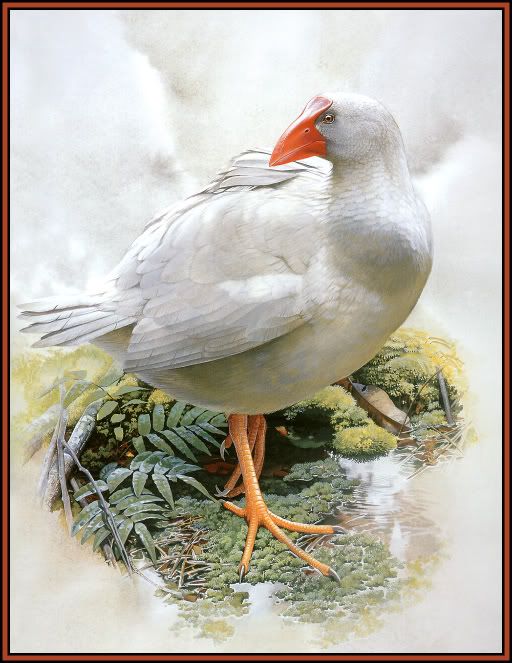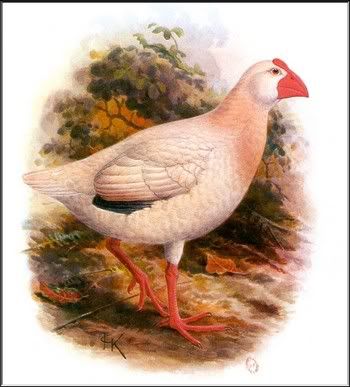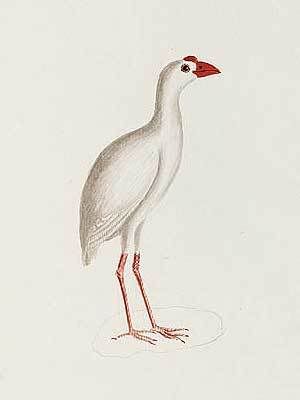|
|
Post by another specialist on Jun 3, 2005 8:30:10 GMT
|
|
|
|
Post by another specialist on Jun 3, 2005 8:31:54 GMT
|
|
|
|
Post by another specialist on Jun 3, 2005 8:55:10 GMT
White Gallinule (Porphyrio albus) Distribution: Lord Howe Island, Australia. Last Record: About 1788. Lord Howe Island was, until 1788, unique in the Pacific Ocean in being a relatively large (1455 hectares), temperate island that had escaped detection by both Polynesian and European explorers. It lies just 570 kilometres off the coast of northern New South Wales, and the first intimation of its existence was a great cloud of seabirds seen in the area by the French explorer La Perouse. He reported this to members of Australia’s First Fleet, who set out in search and sighted the island in March 1788. The place was a convenient larder for the starving convict colony, and in the following years it was systematically plundered. Among the birds found on the island, all of which were remarkably tame, was a stately species with a solid red beak and yellowish-red legs. It was clearly a relative of the cosmopolitan purple swamphen, but was flightless, white, and possessed of a more robust bill. Nothing is known of its habits, but given the purple swamphen’s propensity to carnivory, it may have been a predator on the chicks of the other bird species that swarmed the island. Today the white gallinule is sunk in mystery. Just two skins survive, one in Liverpool and one in Vienna, both of which date to the late eighteenth or early nineteenth centuries and are of somewhat uncertain provenance. Some ornithologists dispute that the skins are from Lord Howe Island at all, but historical records confirm that such a bird once existed on the island. One of Lord Howe’s earliest visitors was surgeon Arthur Bowes Smythe of the Lady Penhryn, who landed in May 1788. So taken was he with the idyllic, palm-clad island and its utterly tame birds that he wrote ‘when I was in the woods amongst the birds I cd. not help picturing to myself the Golden Age as described by Ovid’. Bowes Smythe also wrote of encountering ‘fowls or coots some white, some blue and white, others all blue wt. Large red bills’. Some researchers have speculated that the blue birds were purple gallinules (which still exist on the island today), and that the blue-and-white birds were hybrids with the white gallinule. Others, however, consider that all belonged to one variable species. So little is known of the white gallinule that it is impossible to determine whether it became extinct as early as 1788, or whether it survived until 1834 the island was first settled. Whatever the case it was clearly gone by 1844. The cause of its demise was almost certainly outright slaughter, for it was not timid and could easily be killed with sticks. It is possible that hybridisation with the purple swamphen may also have played a role. Rats and cats cannot be blamed, for they arrived much later. rainforestinfo.org.au/spp/Schouten/white_gallinule.htm |
|
|
|
Post by another specialist on Jun 8, 2005 4:09:31 GMT
|
|
|
|
Post by another specialist on Jun 8, 2005 11:26:14 GMT
Family/Sub-family RALLIDAE Species name author (White, 1790) Taxonomic source(s) Christidis and Boles (1994), Sibley and Monroe (1990, 1993) Taxonomic note Although sometimes considered conspecific with Purple Swamphen P. porphyrio, P. albus had shorter and more robust legs and toes, a smaller bill and softer remiges and rectrices. Summary Porphyrio albus is known from two skins (in Liverpool and Vienna4), several paintings, and some subfossil bones from Lord Howe Island, Australia. Although not uncommon when discovered in 1790, the species was rapidly hunted to extinction by whalers and sailors, and had probably already vanished by the time the island was colonised in 1834. www.birdlife.net/datazone/search/species_search.html?action=SpcHTMDetails.asp&sid=2928&m=0 |
|
|
|
Post by another specialist on Jun 8, 2005 11:27:19 GMT
|
|
|
|
Post by another specialist on Jun 13, 2005 9:02:01 GMT
TAXON SUMMARY White Gallinule 1 Family Rallidae 2 Scientific Name Porphyrio albus (Shaw, 1790) 3 Common Name White Gallinule 4 Conservation status Extinct 5 Reasons for listing The last birds of this subspecies died between 1788 and 1830. 6 Infraspecific taxa None described. Large and flightless with massive skull, long legs and short toes, the White Gallinule is most closely related to the Takahe Notornis mantelli (Hutton, 1991). 7 Past range and abundance The White Gallinule was endemic to Lord Howe I. The species was remarked upon when Lord Howe I. was discovered in 1788, and is thought to have been numerous (Hutton, 1991). As the first settlers on the island in the 1830s did not comment on the species, it had presumably already become Extinct (Hindwood, 1940). Records from Ball's Pyramid and Norfolk Island are considered spurious (Hindwood, 1940, 1965). 8 Ecology The White Gallinule occurred within woodland on the island. It is thought to have been a ground-feeding omnivore that took plants and invertebrates (Hutton, 1991). 9 Reasons for extinction The White Gallinule was hunted with enthusiasm by members of the First Fleet. Almost certainly, hunting by the sailors and subsequent itinerant visitors caused the species' extinction (Hindwood, 1940). www.deh.gov.au/biodiversity/threatened/action/birds2000/pubs/white-gallinule.pdf |
|
|
|
Post by sebbe67 on Oct 25, 2005 21:57:24 GMT
The Lord Howe Swamphen (''Porphyrio albus'') was a large bird in the family Rallidae. It was similar to the Purple Swamphen, but with shorter and more robust legs and toes. Its plumage was white, sometimes blue, and it was probably flightless, like its other close relative the Takahe. This bird was first described by John White in his Journal of a Voyage to New South Wales (1790), which also contained an illustration. It was a resident of Lord Howe Island, Australia. It was not uncommon when the bird was first described, but was soon hunted to extinction by whalers and sailors. There are two skins of the bird in existence, in the museums of Liverpool and Vienna. There are also several paintings, and some subfossil bones.
|
|
|
|
Post by another specialist on Oct 26, 2005 4:08:51 GMT
|
|
|
|
Post by another specialist on Nov 2, 2005 17:15:50 GMT
|
|
|
|
Post by another specialist on Nov 6, 2005 17:05:11 GMT
 Gap in nature |
|
|
|
Post by Meakia'i on Dec 21, 2005 8:58:51 GMT
Another Specialist, You seem to have these beautiful paintings of almost every species! And they all seem to be by the same artist? Who is he?  |
|
|
|
Post by Peter on Dec 22, 2005 16:26:40 GMT
They are made by Peter Schouten. And the images are from the book Gap in Nature. ---------------------------------------------------------------------- Title: Gap in Nature. Subtitle: Discovering the world's extinct animals. Author: Flannery T., Schouten P. Publisher: William Heinemann. ISBN: 0434008192. This book tells the tragic story of how, after Columbus' bold discovery of the Americas in 1492, the impact of European exploration and settlement was to prove fatal for many of the planet's most bizarre and extraordinary creatures. Every part of the planet was effected. These animals had no defence against lethal invaders: people, rats, foxes and cats. In all 103 animals (extinct birds, mammals, and reptiles) are commemorated, some of them are never before illustrated. This book is written by Tim Flannery and breathtakingly illustrated by Peter Schouten.  Thread about this book: extinctanimals.proboards22.com/index.cgi?board=books&action=display&thread=1121355864 |
|
|
|
Post by another specialist on Dec 22, 2005 19:14:10 GMT
Another Specialist, You seem to have these beautiful paintings of almost every species! And they all seem to be by the same artist? Who is he?  Peter beaten me to it ;D yes, all from the same great book |
|
|
|
Post by Meakia'i on Dec 24, 2005 10:10:39 GMT
Ah... very interesting... I really have to find that book now.  |
|
|
|
Post by another specialist on Dec 24, 2005 10:47:09 GMT
Its highly recommended great pictures and info to.
|
|
|
|
Post by another specialist on May 1, 2006 20:49:56 GMT
 another from my computer |
|
|
|
Post by another specialist on Apr 5, 2008 21:25:24 GMT
|
|
|
|
Post by another specialist on Apr 5, 2008 21:26:28 GMT
 Lord Howe Swamphen (Porphyrio albus) artwork by ? from 'Album of watercolour drawings of Australian natural history' from the year ca. 1800 by courtesy of Jennifer Broomhead / State Library of New South Wales www.sl.nsw.gov.au |
|
|
|
Post by another specialist on Apr 30, 2008 19:11:55 GMT
|
|